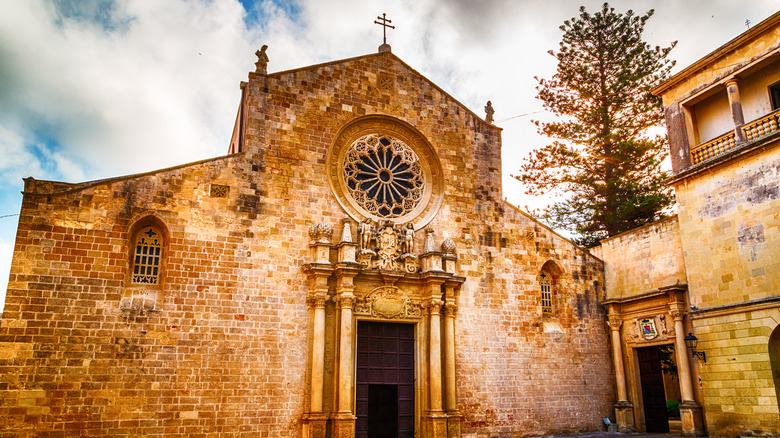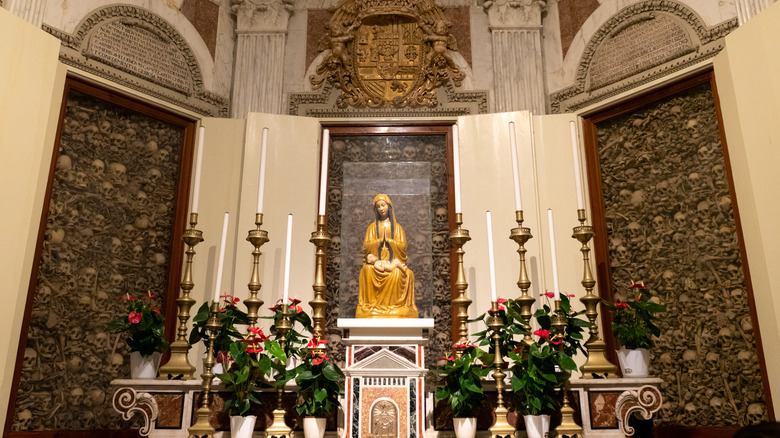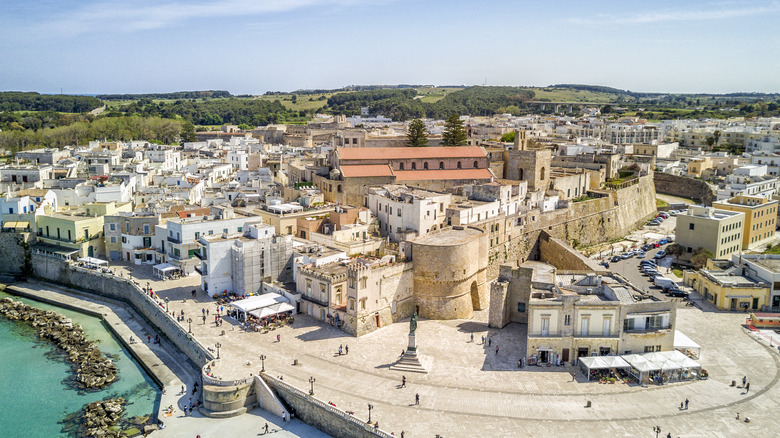This Bone-Chilling Building In Italy Is Recognized As One Of The World's Most Haunted Locations
Deep in the heel of Italy's boot lies Otranto, a sleepy port city on the glittering Adriatic that resembles many other coastal towns in southern Italy. Its coastline is dotted with turquoise bays and picture-perfect beaches, its streets lined with whitewashed buildings and ristoranti serving seafood so fresh it seems to have jumped from the sea straight onto the plate. Originally settled by Greeks and now a popular resort town, Otranto is also a place where the ancient, the medieval, and the modern collide. Having been around for a few millennia, the town has a few stories to tell if you look beneath its modern-day surface. Not all of them are pretty.
One of Otranto's spookiest tales is hiding in its cathedral, the Cattedrale di Santa Maria Annunziata, which was consecrated in 1088. From the outside, it appears to be your average Romanesque cathedral, its telltale rose window like a watchful eye gazing out over the piazza. Walk through the door, and you'll immediately notice the striking floor mosaic that spreads out in all directions — a manic array of religious and historical symbols converging around a giant Tree of Life. Things get spookier from here. When you're ready, take a deep breath and walk all the way through the building to the cappella dei martiri, or chapel of the martyrs. You'll know you've arrived when your jaw hits the floor.
Visiting the chapel of the martyrs
After you reassemble your jaw, take some time to comprehend what you're seeing in the seven huge cases embedded in the chapel walls: bones and skulls, and more bones, and more skulls. These are the remains of 813 men of Otranto who were captured and killed by Turkish invaders on August 14, 1480. After the captive men refused an order to convert to Islam, they were taken to a nearby hill and beheaded one at a time while the others watched, waiting for their turn. Believing this was a key event in deterring the Ottoman conquest of Rome, the Catholic Church declared the 813 victims martyrs and designed the cathedral's cases to preserve and showcase their relics.
You might be horrified to know that the creation of this bone chapel is not an isolated incident. It turns out that there are many other ossuaries throughout the world where deceased persons' remains are housed en masse rather than buried. Sometimes, the bones are arranged to create ornate works of art, as in Austria's Eggenburg Charnel. In other ossuaries, like Palermo's Capuchin Catacombs, whole bodies are pinned to walls, dressed in their Sunday finest, so that family members can visit them on special occasions. This way, family members never have to worry about forgetting what Grandpa Gianni looked like — yikes.
There's another haunted site in Otranto
Returning to Otranto, the cathedral may not actually be the creepiest place in town, if you can believe that. It is said that the Otranto's Castello Aragonese, a hulking fortress strategically positioned on the waterfront that dates back to the 15th century, is home to not just one but two regular ghosts. One is a Spanish woman who was buried in the castle's chapel, while the other is reportedly Count Giulio Antonio Acquaviva di Conversano. According to local legend, the Turkish conquerors of Otranto beheaded the count, but the daring fellow persevered in battle, determined to slaughter his adversaries. Supposedly, the headless knight continues to patrol the castle grounds to this day and occasionally shows up in the dungeon.
In a fitting testament to its eeriness, the castle even served as the setting for the first Gothic novel ever written in the English language — "The Castle of Otranto," published by Horace Walpole in 1764. The novel weaves a dark tale, pitting romance against tragedy and love against terror as the main characters grapple with destiny in the eerie castle, where pictures inexplicably move, doors close by themselves, and apparitions stalk the hallways. Overall, Otranto — with its tragic tales, haunted castle, and bone-chilling ossuary — is clearly a place where macaroni and the macabre are forever joined together. How many destinations can claim that distinction?


